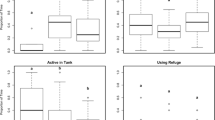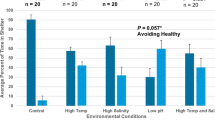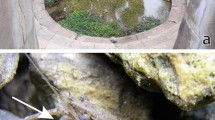Abstract
Red-backed salamanders, Plethodon cinereus, show a variety of alarm responses to chemical cues from eastern garter snakes, Thamnophis sirtalis. We measured the foraging activity of red-backed salamanders exposed to water soiled by a garter snake (fed P. cinereus) or to unsoiled water. Salamanders exposed to snake-soiled water showed less foraging activity than salamanders exposed to unsoiled water; therefore, predators could have nonlethal effects on salamander populations. Our results also show additional factors influenced salamander foraging activity. Salamander foraging activity and responsiveness to chemical cues do not appear to have been affected by sex or food deprivation. Salamander foraging activity does appear to have been influenced by activity biorhythms. Foraging activity of animals in both treatments showed a bimodal periodicity that is consistent with natural activity patterns controlled by internal biorhythms. Exposure to snake-soiled water significantly reduced foraging activity during periods of peak foraging activity, but had a subtler effect0 on foraging activity during natural lulls in activity. We suggest that both activity biorhythms and exposure to chemical cues are important factors affecting salamander foraging behavior.
Similar content being viewed by others
REFERENCES
ADLER, K. 1968. Environmental control of locomotor activity in a salamander (Plethodon glutinosus). PhD dissertation. University of Michigan, Ann Arbor, Michigan.
ADLER, K. 1969. Extraoptic phase shifting of circadian locomotor rhythm in salamanders. Science 164:1290-1291.
ADLER, K. 1970. The role of extraoptic photoreceptors in amphibian rhythms and orientation: A review. J. Herpetol. 4:96-112.
ARNOLD, S. J. 1982. A quantitative approach to antipredator performance: salamander defense against snake attack. Copeia 1982:247-253.
BERNARDO, J. 1994. Experimental analysis of allocation in two divergent, natural salamander populations. Am. Nat. 143:14-38.
CHIVERS, D. P., KIESECKER, J. M., WILDY, E. L., ANDERSON, M. T., and BLAUSTEIN, A. R. 1997. Chemical alarm signalling in terrestrial salamanders: Intra-and interspecific responses. Ethology 103:599-613.
CUPP, P. V. 1994. Salamanders avoid chemical cues from predators. Anim. Behav. 48:232-235.
DAKIN, S. F. 1978. The influence of interspecific competition on the microhabitat distribution of terrestrial lungless salamanders in the southern Appalachian mountains. PhD dissertation. Duke University, Durham, North Carolina.
DODD, C. K., JR. 1989. Duration of immobility in salamanders, genus Plethodon (Caudata: Plethodontidae). Herpetologica 45:467-472.
DUCEY, P. K., and BRODIE, E. D., JR. 1983. Salamanders respond selectively to contacts with snakes: Survival advantage of alternative antipredator strategies. Copeia 1983:1036-1041.
FEDER. M. E. 1983. Integrating the ecology and physiology of plethodontid salamanders. Herpetologica 39:291-310.
FRASER, D. F. 1976. Empirical evaluation of the hypothesis of food competition in salamanders of the genus Plethodon. Ecology 57:459-471.
FRASER, D. F. 1980. On the environmental control of oocyte maturation in a plethodontid salamander. Oecologia 46:302-307.
GODIN, J.-G. J., and CROSSMAN, S. L. 1994. Hunger-dependent predator inspection and foraging behaviours in the threespine stickleback (Gasterosteus aculeatus) under predation risk. Behav. Ecol. Sociobiol. 34:359-366.
GODIN, J.-G. J., and SMITH, S. A. 1988. A fitness cost of foraging in the guppy. Nature 333:69-71.
HORAT, P., and SEMLITSCH, R. D. 1994. Effects of predation risk and hunger on the behaviour of two species of tadpole. Behav. Ecol. Sociobiol. 34:393-401.
JAEGER, R.G. 1978. Plant climbing by salamanders: Periodic availability of plant-dwelling prey. Copeia 1978:686-691.
JAEGER, R. G. 1980. Fluctuations in prey availability and food limitation for a terrestrial salamander. Oecologia 44:335-341.
JAEGER, R. G. 1990. Territorial salamanders evaluate size and chitinous content of arthropod prey, pp. 111-126, in R. N. Hughes (ed.). Behavioral Mechanisms of Food Selection. Springer-Verlag, Berlin, Germany.
KATS, L. B., and DILL, L.M. 1998. The scent of death: Chemosensory assessment of predation by prey animals. Ecoscience 5:361-394.
KRISHNAN, B., DRYER, S. E., and HARDIN, P. E. 1999. Circadian rhythms in olfactory responses of Drosophila melanogaster. Nature 400:375-378.
LAURILA, A., and KUJASALO, J. 1999. Habitat duration, predation risk and phenotypic plasticity in common frog (Rana temporaria) tadpoles. J. Anim. Ecol. 68:1123-1132.
LAURILA, A., KUJASALO, J., and RANTA, E. 1998. Predator-induced changes in life history in two anuran tadpoles: Effects of predator diet. Oikos 83:307-317.
LIMA, S. L. 1998. Nonlethal effects in the ecology of predator-prey interactions: What are the ecological effects of anti-predator decision-making? BioScience 48:25-34.
LIMA, S. L., and DILL, L. M. 1990. Behavioral decisions made under the risk of predation: A review and prospectus. Can. J. Zool. 68:619-640.
MADISON, D. M., MAERZ, J. C., and MCDARBY, J. D. 1999a. Chemosensory avoidance of snake odors by salamanders: Freeze and flight contingencies, pp. 508-516 in R. E. Johnston, D. Müller-Schwarze, and P. Sorensen (eds.). Advances in Chemical Communication in Vertebrates. Kluwer Academic/Plenum Press, New York.
MADISON, D. M., MAERZ, J. C., and MCDARBY, J. D. 1999b. Optimization of predator avoidance by salamanders using chemical cues: Diet and diel effects. Ethology 105:1073-1086.
MAERZ, J. C. 2000. Prey availability and phenotypic differences between local terrestrial salamander populations. PhD dissertation. State University of New York at Binghamton, Binghamton, New York.
MCDARBY, J. D., Madison, D. M., and Maerz, J. C. 1999. Chemosensory avoidance of predators by the red-backed salamander, Plethodon cinereus, pp. 489-495, in R. E. Johston, D. Müller-Schwarze, and P. Sorensen (eds.). Advances in Chemical Communication in Vertebrates. Kluwer Academic/Plenum Publishers, New York.
MURRAY, D. L., and JENKINS, C. L. 1999. Perceived predation risk as a function of predator dietary cues in terrestrial salamanders. Anim. Behav. 57:33-39.
PEACOR, S. D., and WERNER E. E. 2000. Predator effects on an assemblage of consumers through induced changes in consumer foraging behavior. Ecology 81:1998-2010.
PERSSON, L. 1999. Trophic cascades: Abiding heterogeneity and trophic level concept at the end of the road. Oikos 85:385-397.
POUGH, F. H. 1983. Amphibians and reptiles as low-energy systems, pp. 141-188, in W. P. Aspey and S. I. Lustick (eds.). Behavioral Energetics: The Cost of Survival in Vertebrates. Ohio State University Press, Columbus, Ohio.
RELYEA, R. A. 2000. Trait-mediated indirect effects in larval anurans: reversing competition with the threat of predation. Ecology 81:2278-2289.
RELYEA, R. A., and WERNER, E. E. 1999. Quantifying the relation between predator-induced behavior and growth performance in larval amphibians. Ecology 80:2117-2124.
SKELLY, D. K. 1994. Activity level and the susceptibility of anuran larvae to predation. Anim. Behav. 47:465-468.
TURNER, A. M. 1997. Contrasting short-term and long-term effects of predation on consumer habitat use and resources. Behav. Ecol. 8:120-125.
TURNER, A. M., and MITTELBACH, G. G. 1990. Predator avoidance and community structure: Interactions among piscivores, planktivores, and plankton. Ecology 71:2241-2254.
WERNER, E. E., and ANHOLT, B. R. 1996. Predator-induced behavioral indirect effects: Consequences to competitive interactions in anuran larvae. Ecology 77:157-169.
WHITHAM, J., and MATHIS, A. 2000. Effects of hunger and predation risk on foraging behavior of graybelly salamanders, Eurycea multiplicata. J. Chem. Ecol. 26:1659-1665.
Author information
Authors and Affiliations
Rights and permissions
About this article
Cite this article
Maerz, J.C., Panebianco, N.L. & Madison, D.M. Effects of Predator Chemical Cues and Behavioral Biorhythms on Foraging, Activity of Terrestrial Salamanders. J Chem Ecol 27, 1333–1344 (2001). https://doi.org/10.1023/A:1010309108210
Issue Date:
DOI: https://doi.org/10.1023/A:1010309108210




